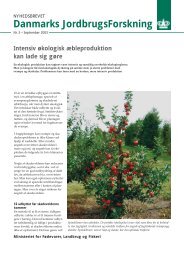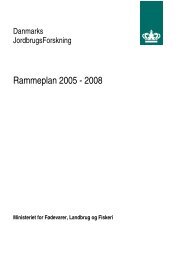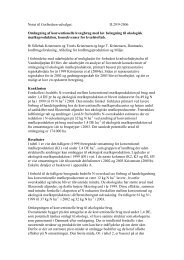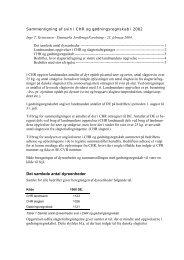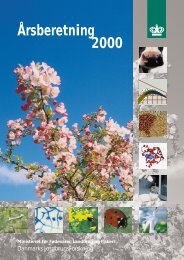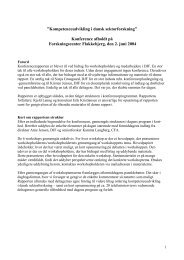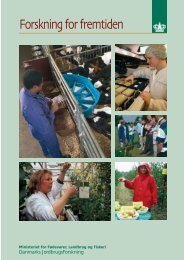Reproduction performances and conditions of group-housed non ...
Reproduction performances and conditions of group-housed non ...
Reproduction performances and conditions of group-housed non ...
Create successful ePaper yourself
Turn your PDF publications into a flip-book with our unique Google optimized e-Paper software.
- Appendix 1 -<br />
Soon after ovulation the granulosa cells lining the follicle wall begins to multiply to form a<br />
corpus luteum (CL) (Anderson, 2000). If fertilisation does not occur, prostagl<strong>and</strong>in pro-<br />
duced by the uterus is transferred to the ovary were it induces regression <strong>of</strong> CL. Corpus<br />
Luteum is essential for maintenance <strong>of</strong> pregnancy because CL is the only source <strong>of</strong> proges-<br />
terone in the sow <strong>and</strong> progesterone is essential during the whole period <strong>of</strong> pregnancy (van<br />
der Lende, 1989). The main function <strong>of</strong> CL is the secretion <strong>of</strong> progesterone. Progesterone<br />
stimulates uterine secretions (among other things IGF-1) <strong>and</strong> progesterone is the primary<br />
director <strong>of</strong> uterine development <strong>and</strong> secretion (Geisert & Yelich, 1997). Furthermore pro-<br />
gesterone is necessary to prevent contractions <strong>of</strong> the uterus, which would be caused by ele-<br />
vated levels <strong>of</strong> oestrogen (Hughes et al., 1996). Both oestrogen (Strob<strong>and</strong> & Lende, 1990)<br />
<strong>and</strong> progesterone are involved in preparing the uterine wall for the attachment <strong>of</strong> the em-<br />
bryos (Hughes & Varley, 1980). There are indications that LH is essential for maintenance<br />
<strong>of</strong> the CL beyond the first 12 days <strong>of</strong> pregnancy but that this requirement for LH decreases<br />
after day 29 <strong>of</strong> pregnancy (Peltoniemi et al., 1995; Hughes et al., 1996). To avoid regres-<br />
sion <strong>of</strong> CL at day 16 in oestrus cycle the embryo around day 11-12 secretes oestrogen<br />
(Bazer et al., 1982; Geisert & Yelich, 1997). This is also called ‘the embryonic signal’<br />
(Peltoniemi et al., 2000) or ‘the maternal recognition signal’ (Geisert et al., 1987). Accord-<br />
ing to Bazer et al. (1982;1984) oestrogen produced by the embryo directs the prostagl<strong>and</strong>in<br />
synthesised in the uterus into the uterine lumen which prevent their release to the uterine<br />
vascular bed <strong>and</strong> therefore prevents the regression <strong>of</strong> CL. Oxytocin (Geisert & Yelich,<br />
1997), which secretion from the endometrium is stimulated by oestrogen, <strong>and</strong> prolactin<br />
(Gross et al., 1990 cf Geisert et al., 1994) may also play a role in this redirection <strong>of</strong> pros-<br />
tagl<strong>and</strong>in. Bazer et al. (1984) suggested that prostagl<strong>and</strong>in is only luteolytic on day 12 or<br />
later after onset <strong>of</strong> oestrus. However, Estill et al. (1993) found that repeated treatment with<br />
prostagl<strong>and</strong>in from day five to day ten also resulted in luteolysis. Geisert et al. (1994) hy-<br />
pothesise that, before the first embryonic signal, progesterone controls the release <strong>of</strong> pros-<br />
tagl<strong>and</strong>in. It seems that a second prolonged embryonic oestrogen signal is required after<br />
day 14 to maintain pregnancy beyond day 30 (Geisert et al., 1987).<br />
At the time <strong>of</strong> parturition foetal cortisol stimulate the prostagl<strong>and</strong>in production in the<br />
uterus, which causes regression <strong>of</strong> the CL followed by a drop in progesterone level (Hughes<br />
et al., 1996; Anderson, 2000).<br />
Discussion<br />
The above-mentioned emphasize that a successful reproduction depends upon a series <strong>of</strong><br />
precisely timed physiological <strong>and</strong> endocrine events. These events may be disturbed by<br />
various factors. There are thus indications that the endocrine regulation may be disturbed<br />
by e.g. stress, as indicated by increased cortisol. In several studies, administration <strong>of</strong> corti-<br />
115




